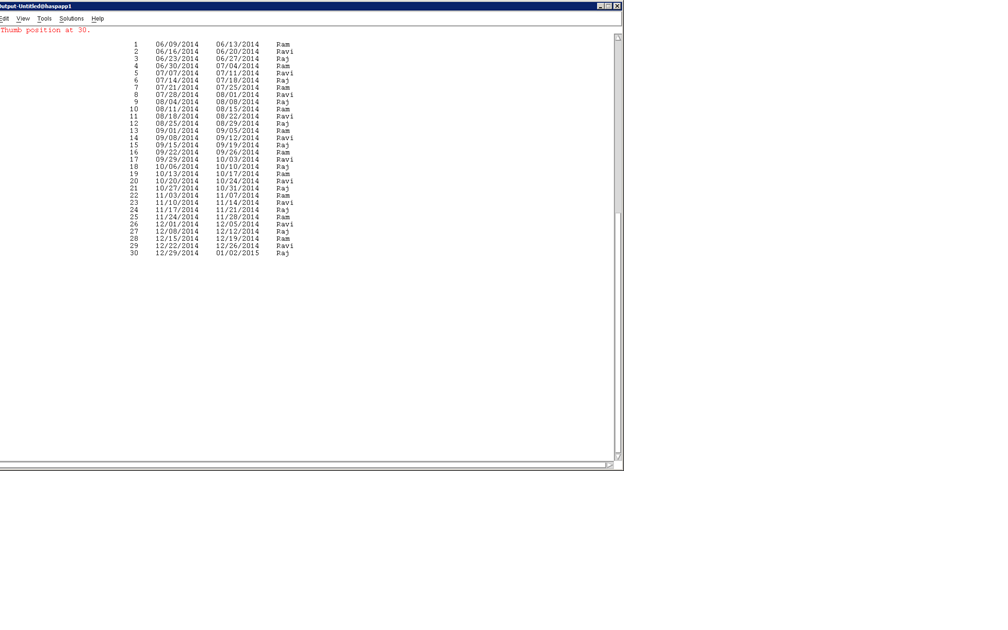- Home
- /
- Programming
- /
- SAS Procedures
- /
- How to get the data based on weekdays?
- RSS Feed
- Mark Topic as New
- Mark Topic as Read
- Float this Topic for Current User
- Bookmark
- Subscribe
- Mute
- Printer Friendly Page
- Mark as New
- Bookmark
- Subscribe
- Mute
- RSS Feed
- Permalink
- Report Inappropriate Content
Errrm, then just add format into mine?
data want (drop=j);
format start_date end_date date9.;
do name="Raj","Ravi","Ram";
do j=0 to 3;
start_date=intnx('week','06FEB2014'd,j);
end_date=intnx('week','06JUN2014'd,j);
output;
end;
end;
run;
- Mark as New
- Bookmark
- Subscribe
- Mute
- RSS Feed
- Permalink
- Report Inappropriate Content
thanks - Format is fine. But I need the output as I mentioned earlier.
- Mark as New
- Bookmark
- Subscribe
- Mute
- RSS Feed
- Permalink
- Report Inappropriate Content
Ah, I see. Its three day gaps or something similar. Check out the SAS docs: SAS(R) 9.3 Functions and CALL Routines: Reference
You can use DAY3 or whatever your interval is, and change the J loop to be how many times you want it:
data want (drop=j);
format start_date end_date date9.;
do name="Raj","Ravi","Ram";
do j=0 to 3;
start_date=intnx('day3','06FEB2014'd,j);
end_date=intnx('day3','06JUN2014'd,j);
output;
end;
end;
run;
- Mark as New
- Bookmark
- Subscribe
- Mute
- RSS Feed
- Permalink
- Report Inappropriate Content
I think you've misunderstood my question. I agree with you, but I looking for end date is startdate+4 days and not 06jun2014.
i need the output as below

- Mark as New
- Bookmark
- Subscribe
- Mute
- RSS Feed
- Permalink
- Report Inappropriate Content
data want (drop=j);
format start_date end_date date9.;
do name="Raj","Ravi","Ram";
do j=0 to 3;
start_date=intnx('day3','06FEB2014'd,j);
end_date=intnx('day3',start_date,j); /* Think you can change this to day4 if that's whats needed */
output;
end;
end;
run;
- Mark as New
- Bookmark
- Subscribe
- Mute
- RSS Feed
- Permalink
- Report Inappropriate Content
Thanks for your suport and patience. But still it is now working as i expect.
See the output below for your code after I changed day 3 to day4 in end_date variable
obs start_date end_date name
1 04FEB2014 02FEB2014 Raj
2 07FEB2014 10FEB2014 Raj
3 10FEB2014 18FEB2014 Raj
4 13FEB2014 22FEB2014 Raj
5 04FEB2014 02FEB2014 Rav
6 07FEB2014 10FEB2014 Rav
7 10FEB2014 18FEB2014 Rav
8 13FEB2014 22FEB2014 Rav
9 04FEB2014 02FEB2014 Ram
10 07FEB2014 10FEB2014 Ram
11 10FEB2014 18FEB2014 Ram
12 13FEB2014 22FEB2014 Ram
- Mark as New
- Bookmark
- Subscribe
- Mute
- RSS Feed
- Permalink
- Report Inappropriate Content
Yes, just change the j in the second intnx to be one as this part is linked to start_date not to the do loop:
data want (drop=j);
format start_date end_date date9.;
do name="Raj","Ravi","Ram";
do j=0 to 3;
start_date=intnx('day4','06FEB2014'd,j);
end_date=intnx('day4',start_date,1); /* Think you can change this to day4 if that's whats needed */
output;
end;
end;
run;
So start date will be 4 day intervals 3 times based on the loop, end_date is 4 days after start_date.
- Mark as New
- Bookmark
- Subscribe
- Mute
- RSS Feed
- Permalink
- Report Inappropriate Content
data want (drop=j); CALL SYMPUTX('DATE1', '01JAN2014'D); do name= "RAJ", "RAVI", "RAM"; DO J=0 TO 52; START_DATE= PUT(INTNX('WEEK',SYMGET('DATE1'),J,'B') +1, DATE9.); END_DATE = PUT(INTNX('WEEK',SYMGET('DATE1'),J,'E')-1, DATE9.); OUTPUT; END; END; RUN;
- Mark as New
- Bookmark
- Subscribe
- Mute
- RSS Feed
- Permalink
- Report Inappropriate Content
*Make a dateset with your agents;
data agents;
input name $;
datalines;
Raj
Ravi
Ram
;
run;
data schedule;
set agents;
*start date as monday;
start=intnx('week', today(), 0)+1; * +1 to get monday. Change 0 to +1 for next week ;
do start_date = start to '31dec2014'd by 6;
end_date=start_date +4;
output;
end;
format start_date end_date ddmmyy10.;
drop start;
run;
- « Previous
-
- 1
- 2
- Next »
April 27 – 30 | Gaylord Texan | Grapevine, Texas
Registration is open
Walk in ready to learn. Walk out ready to deliver. This is the data and AI conference you can't afford to miss.
Register now and lock in 2025 pricing—just $495!
Learn the difference between classical and Bayesian statistical approaches and see a few PROC examples to perform Bayesian analysis in this video.
Find more tutorials on the SAS Users YouTube channel.
SAS Training: Just a Click Away
Ready to level-up your skills? Choose your own adventure.

